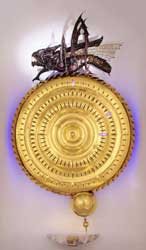
Posted to News on 24th Sep 2008, 22:12
Corpus Clock has mechanical escapement but no hands
Huxley Bertram Engineering has played a major role in constructing one of the world's most unusual clocks.

The Corpus Clock is a new type of clock, said to be the first of its kind and with six patented features. It is also a piece of public art, having the power to mesmerise onlookers and challenge perceptions of the nature of time.
Created specially for the exterior of a new library building, the clock was conceived by Dr John Taylor, who studied at the College in the 1950s. Built by a team of high-precision engineers and master craftsmen, the clock was unveiled by Professor Stephen Hawking on 19 September 2008 (click here for a larger image of the clock).
In parallel with a long and successful career as an inventor, during which he has patented over 150 inventions, John Taylor has had a passion for horology and an interest in creating a true mechanical spring-driven clock in the best tradition of the early English clockmakers Harrison of 'Longitude' fame. Indeed Harrison's 'grasshopper escapement' is one of the main influences on the Corpus Clock. However, instead of being hidden inside the clock, the escapement is external and enlarged, taking the form of a chronophage (time-eater) - a fearsome beast that drives the clock, literally eating time. It is believed to be the largest grasshopper escapement of any clock in the world.
But as well as performing its escapement function, the chronophage has a repertoire of slow blinks, jaw-snaps and tail movements. Below the monster, the time-telling part of the clock is also highly dynamic. The clock has no hands or digital numbers; instead vernier slits are cut into the face. Blue LEDs are arranged behind the slits so that when the escape wheel moves, lights appear to dart in concentric circles and pause at the correct hour, minute and second. So although the lights give the illusion of flashing in sequence, they are actually exposed mechanically. The clock's total power consumption is less than 60W.
Click here for an image of the inside of the clock.
Click here to watch a movie in which John Taylor explains how the clock works.
The Corpus Clock has taken seven years to develop and is reported to have cost 1million. Its gold-plated face, over 1m in diameter, was formed from a single sheet of stainless steel using precisely-controlled underwater explosions. The chronophage drives the escape wheel, which rotates on the inside of the clock, and, while the arm of the pendulum is inside the clock, its terminal (or 'bob') protrudes below, swinging above a dish decorated with the Corpus Christi crest.
On the hour, a chain drops into a wooden coffin behind the clock, the sound of which is said to remind us of our mortality. On a brighter note, the clock plays tricks on the observer, seeming occasionally to pause, run unevenly and even go backwards. All of this is achieved through mechanics rather than computer programming.
There have been few significant advances in mechanical clock design since the eighteenth century. While John Taylor's new clock is a traditional timepiece, driven by a spring, it measures and tells time in a completely novel way.
The time team
Dr John Taylor, inventor and designer of the Corpus Clock, brought together an exceptional team of craftsmen, engineers and skilled technicians. It was constructed principally in the workshops of Huxley Bertram Engineering near Cambridge.
Stewart Huxley, a long-term collaborator of Dr Taylor's, is a Director of Huxley Bertram Engineering, a high-precision industrial engineering design and manufacturing company near Cambridge. Together with the other members of the project team Stewart Huxley turned John Taylor's concept and drawings into reality. The Corpus Clock embodies no less than six new inventions and patents.
Other members of the team that created the Corpus Clock included: Gary Moore, industrial designer; Matthew Lane Sanderson, sculptor; Joan Mackarell enameller; Clare and Sandy Wright, architects; Tyra Till, design consultant and project manager; and Dr Christopher de Hamel, Fellow librarian at Corpus Christi College. The term chronophage was suggested by Ian Brookes of Chambers Dictionaries and is derived from the Greek for 'time' and 'eater.'
Want the latest machine building news straight to your inbox? Become a MachineBuilding member for free today >>

















